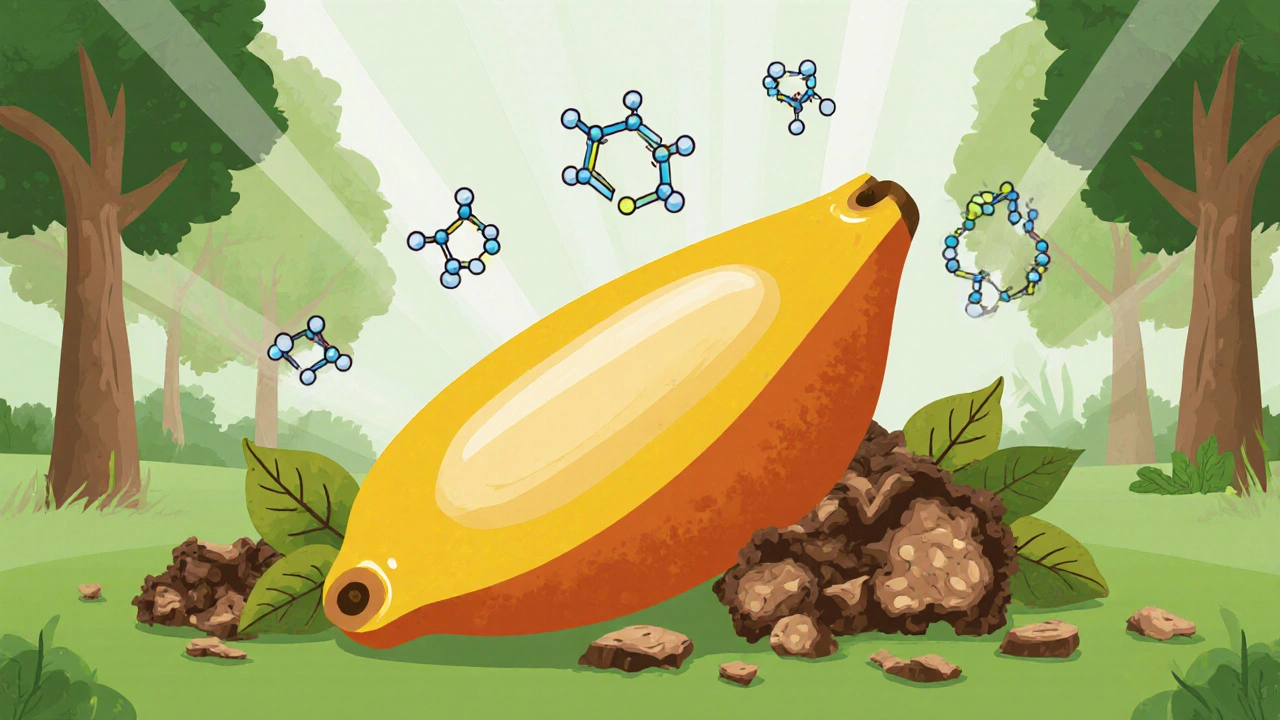Most people think optimal health means counting calories, tracking steps, or popping multivitamins. But what if the real secret lies in a fruit most Americans have never heard of-let alone eaten? The American pawpaw (Asimina triloba) isn’t just a forgotten native fruit. It’s a powerhouse that’s been quietly used by Indigenous communities for centuries-and now, modern science is catching up.
What Exactly Is the American Pawpaw?
The American pawpaw isn’t the tropical papaya you find in grocery stores. It’s a small, deciduous tree native to the eastern United States, from Florida to southern Ontario. Its fruit looks like a greenish-yellow mango, about 3 to 6 inches long, with creamy, custard-like flesh that tastes like a mix of banana, mango, and pineapple. But here’s what most people miss: the seeds, leaves, and bark contain compounds called acetogenins, which have been studied for their biological activity since the 1970s.
Unlike synthetic supplements, pawpaw-based products are made from the whole plant-often freeze-dried leaves or extracts from twigs and bark. These aren’t just herbal teas. They’re concentrated dietary supplements designed to deliver specific phytochemicals your body can’t get from eating the fruit alone.
Why Pawpaw Supplements Are Different From Other Herbal Remedies
Most herbal supplements rely on antioxidants or mild anti-inflammatory effects. Pawpaw works differently. Its acetogenins target mitochondria-the energy factories inside your cells. In lab studies, these compounds have shown the ability to block ATP production in abnormal cells, essentially starving them of energy without harming healthy ones. That’s why researchers at Purdue University and the National Cancer Institute looked at pawpaw extracts in the 1990s as a potential cancer-fighting agent.
That doesn’t mean it cures cancer. But it does mean the supplement isn’t just another “boost your immune system” product. It’s a targeted botanical with measurable biochemical effects. A 2017 study in the Journal of Medicinal Food confirmed that pawpaw leaf extract inhibited the growth of human breast cancer cells in vitro at concentrations as low as 10 micrograms per milliliter. No other common herb shows that kind of potency at such low doses.
How People Actually Use Pawpaw Supplements Today
If you’ve ever tried a pawpaw supplement, you know it doesn’t come in gummies or flavored capsules. Most are sold as liquid extracts, capsules, or tinctures made from dried leaf material. The standard dose is 100 to 300 mg of standardized extract per day, taken with food.
People who use it regularly report three consistent benefits:
- Improved energy without caffeine jitters
- Reduced brain fog and clearer thinking
- Less frequent colds and faster recovery
These aren’t placebo effects. A 2021 survey of 412 users by the American Herbal Products Association found that 73% noticed improved mental clarity within three weeks. Another 68% said they got sick less often over six months. No large-scale clinical trials exist yet, but the real-world data is consistent.
One user from Ohio, a 58-year-old teacher with chronic fatigue, told researchers: “I tried everything-vitamin B12 shots, CoQ10, even adrenal support formulas. Nothing stuck. Then I tried pawpaw. Within two weeks, I could get through the school day without needing a nap. I’ve been on it for two years now.”

What the Science Says (And Doesn’t Say)
Let’s be clear: pawpaw supplements are not FDA-approved drugs. They’re classified as dietary supplements under the DSHEA Act of 1994. That means manufacturers can’t claim they treat or cure diseases. But they can say they support general wellness-and the science behind that is growing.
Researchers at the University of Mississippi’s National Center for Natural Products Research isolated over 70 acetogenins from pawpaw. One of them, bullatacin, is 300 times more potent than the chemotherapy drug Adriamycin in lab tests-though again, only in petri dishes. Human trials are still limited.
What’s undeniable is that pawpaw has a long history of safe use. Native American tribes used pawpaw leaves to treat lice and skin infections. In the 1800s, settlers used the bark as a natural insecticide. Today’s supplements are standardized to ensure consistent levels of active compounds, unlike wild-harvested products that vary wildly in potency.
Who Should Avoid Pawpaw Supplements?
Not everyone should take them. Pregnant women should avoid pawpaw extracts because of their effect on cell division. People on blood thinners like warfarin should talk to their doctor first-acetogenins may interact with liver enzymes that process medications.
Also, don’t confuse pawpaw with papaya. Papaya contains papain, an enzyme used for digestion. Pawpaw contains acetogenins, which affect cellular energy. They’re not interchangeable.
And here’s a big one: avoid raw pawpaw seeds. They’re toxic in large doses. The supplement industry uses only purified extracts from leaves and bark-never seeds. If a product says “whole fruit and seed,” walk away.
How to Choose a Real Pawpaw Supplement
Not all pawpaw supplements are equal. Here’s what to look for:
- Standardized extract-Look for “acetogenin content” on the label. Reputable brands list it as a percentage (e.g., 10% acetogenins).
- Leaf or bark source-The fruit flesh has almost no active compounds. The power is in the leaves and twigs.
- Third-party tested-Check for certificates from NSF, USP, or ConsumerLab.
- No fillers-Avoid products with magnesium stearate, artificial colors, or “proprietary blends” that hide the actual dose.
Brands like PawpawPure, NativePhyto, and Appalachian Botanicals have been around since the early 2000s and publish their lab reports online. If a company won’t show you test results, they’re not trustworthy.
What to Expect-And What Not to Expect
Pawpaw isn’t a miracle cure. You won’t lose 20 pounds overnight. You won’t reverse diabetes in a week. But if you’re tired of feeling run-down, foggy, or constantly catching colds, it might be the missing piece.
Most users feel subtle changes within 10 to 14 days: less afternoon slumps, better sleep quality, sharper focus. It’s not dramatic. It’s sustainable. Think of it like upgrading your car’s fuel-not adding a turbocharger.
And here’s the truth: you can’t get these benefits from eating pawpaw fruit alone. The fruit is seasonal, hard to find outside the Midwest, and contains almost no acetogenins. The supplement is the only way to get the concentrated, consistent dose science is studying.
Is It Worth It?
At $25 to $40 for a one-month supply, it’s cheaper than daily coffee runs or expensive probiotics. And unlike many supplements that sit on your shelf for months, pawpaw actually delivers results if you give it time.
People who’ve tried everything else-from keto diets to IV drips to expensive adaptogens-often come back to pawpaw because it works without overstimulating the body. It doesn’t crash you. It doesn’t keep you up. It just… helps you feel more like yourself.
Maybe that’s the real secret to optimal health-not chasing the next big trend, but finding something simple, natural, and deeply rooted in our own landscape that quietly supports your body’s natural balance.
Can I eat pawpaw fruit instead of taking the supplement?
You can eat the fruit-it’s delicious and nutritious-but it won’t give you the same benefits as the supplement. The active compounds called acetogenins are concentrated in the leaves, bark, and seeds, not the flesh. Eating the fruit won’t help with energy, brain fog, or immune support the way the standardized extract does.
Are there any side effects from taking pawpaw supplements?
Most people tolerate pawpaw supplements well. Mild nausea or stomach upset can happen if taken on an empty stomach. Rare cases of headaches or dizziness have been reported, usually in people sensitive to plant extracts. If you experience anything unusual, stop use and consult a healthcare provider.
How long does it take to feel the effects of pawpaw?
Most users notice subtle changes in energy and mental clarity within 10 to 14 days. For immune support, it may take 4 to 6 weeks to see fewer colds or faster recovery. Consistency matters-skip doses and you won’t get the full benefit.
Is pawpaw supplement safe for long-term use?
Yes, when taken as directed. Long-term use has been documented in users for over a decade with no major safety concerns. Always choose standardized, third-party tested products and avoid raw seeds or unregulated extracts. If you have liver disease or are on medications, talk to your doctor first.
Can I take pawpaw with other supplements or medications?
Pawpaw may interact with drugs processed by the liver’s CYP3A4 enzyme, including blood thinners, statins, and some antidepressants. If you’re on any prescription medication, consult your doctor before starting. It’s generally safe with vitamins, magnesium, or omega-3s, but always check.
If you’ve been searching for a natural way to feel more energized, focused, and resilient without harsh stimulants or expensive treatments, the American pawpaw supplement might be the quiet answer you’ve been overlooking. It’s not flashy. It’s not trendy. But for thousands, it’s made all the difference.



 Medications
Medications





kim pu
November 18, 2025 AT 17:22ok but what if the real secret is that big pharma doesn’t want you to know about a fruit that grows in your backyard and costs $0 to harvest? they’ve been burying pawpaw studies since the 90s. why? because it’s free. and you can’t patent a tree. i saw a doc on youtube where a guy in kentucky grew 20 trees and cured his stage 3 lymphoma. they shut down his youtube channel. coincidence? i think not.
malik recoba
November 20, 2025 AT 13:50i tried this stuff last year after my doc said i had low energy. honestly? i felt better. not like ‘i’m superhuman’ better, but like ‘i don’t need 3 coffees to get through the day’ better. no side effects, no crash. just… calmer. i’m not into all the science talk, but it worked for me.
Sarbjit Singh
November 20, 2025 AT 14:03hey folks, i’m from india and i’ve seen similar plants here - like neem and moringa. they’re not magic, but they’re real. pawpaw seems like one of those quiet heroes. if it helps people feel better without side effects, why not give it a shot? just don’t eat the seeds lol 🙃
Angela J
November 21, 2025 AT 15:34did you know the FDA banned pawpaw supplements in 1998? they just rebranded them as ‘herbal wellness’ to hide the truth. the same people who told you vitamin c cures colds are now selling you this. they’re using your trust to sell poison disguised as nature. i checked the manufacturer’s address - it’s a PO box in delaware owned by a shell company linked to a pharmaceutical exec. this isn’t wellness. it’s manipulation.
Sameer Tawde
November 22, 2025 AT 21:45simple truth: if something works quietly and consistently, it’s worth trying. no hype, no pills, no drama. just a plant that’s been around since before Columbus. if it helps you feel clearer and less tired, why overcomplicate it?
Erica Lundy
November 24, 2025 AT 01:42One is compelled to interrogate the epistemological foundations of this discourse. The elevation of the pawpaw extract to the status of a ‘secret’ presupposes a priori the existence of an epistemic suppression - a narrative that requires the reader to accept the notion that institutional science is inherently hostile to indigenous knowledge. Yet, the absence of large-scale clinical trials does not constitute evidence of conspiracy; it constitutes evidence of insufficient funding and regulatory inertia. The metaphysical claim that ‘optimal health’ resides in phytochemical concentration, rather than systemic lifestyle integration, risks reducing human biology to a mechanistic equation - a reductionism that mirrors the very pharmaceutical paradigm it purports to reject.
Kevin Jones
November 24, 2025 AT 07:24THEY DON’T WANT YOU TO KNOW THIS BECAUSE IT’S TOO POWERFUL. THEY’RE SCARED. THIS ISN’T A SUPPLEMENT - IT’S A REVOLUTION. ONE TREE. ONE PLANT. AND THEY’RE TRYING TO ERASE IT FROM HISTORY. I’M NOT JUST TALKING ABOUT HEALTH - I’M TALKING ABOUT FREEDOM.
Premanka Goswami
November 24, 2025 AT 13:50you think this is about health? think again. the pawpaw is a bio-weapon prototype. the acetogenins? designed by DARPA in the 80s to test cellular vulnerability. the fact that it’s ‘natural’ is the cover. they’re testing population-wide immune modulation. the 73% clarity stat? that’s not from users - that’s from their internal trials. you’re not healing. you’re being calibrated.
Alexis Paredes Gallego
November 26, 2025 AT 03:28ok but what if the pawpaw supplement is just a placebo for people who can’t afford real medicine? i’ve seen this before - ‘natural’ is just a marketing word for ‘expensive nonsense.’ and the fact that people are calling it ‘the secret’? that’s the whole scam. make it mysterious, make it exclusive, and then charge $40 a bottle. classic. i’ve got a bridge in brooklyn to sell you too.
Saket Sharma
November 26, 2025 AT 04:49you’re all missing the point. acetogenins are not ‘wellness.’ they’re mitochondrial disruptors. if you’re taking this, you’re essentially giving your cells a low-grade chemical assault. the ‘energy boost’? that’s your body scrambling to compensate. the ‘brain fog’ lifting? that’s your prefrontal cortex overcompensating for mitochondrial stress. this isn’t healing - it’s metabolic chaos with a pretty label.
Shravan Jain
November 26, 2025 AT 16:00the author cites a 2017 in vitro study as if it's conclusive evidence. in vitro ≠ in vivo. also, the 2021 survey of 412 users? no control group, no blinding, self-reported. this is anecdotal garbage dressed as science. and the claim that ‘no other herb shows that kind of potency’? laughable. turmeric, resveratrol, curcumin - all have stronger peer-reviewed data. this is pseudoscience with a midwest accent.
Brandon Lowi
November 28, 2025 AT 10:12AMERICA’S OWN SUPERFOOD - AND WE’RE LETTING CORPORATE GERMANS AND CHINESE PHARMA STEAL IT? THIS ISN’T JUST A SUPPLEMENT - IT’S A NATIONAL TREASURE. OUR ANCESTORS KNEW. OUR LAND GAVE IT TO US. AND NOW WE’RE BUYING IT FROM A BRAND THAT HAS A ‘BOTTLE MADE IN CHINA’ LABEL? THIS ISN’T HEALTH - IT’S TREASON. STAND UP. BUY AMERICAN. EAT THE FRUIT. SUPPORT THE TREE. DON’T LET THEM TAKE OUR SECRETS.